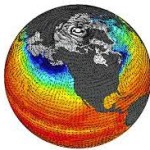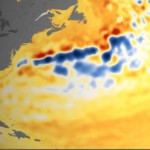By supercomputing standards, Argonne National Lab’s Bebop (stood up in 2017, 1.75 teraflops, bumped off the Top500 list after the June 2019 ranking) seems something of a second-tier player. But veteran, formerly non-Top500 systems like Bebop can still take a star turn, as shown by the results of a research team from Northern Illinois University […]
Latest Climate Models Predict Thinner Clouds and More Global Warming
Thanks to clouds, latest climate models predict more global warming than their predecessors. Researchers at LLNL in collaboration with colleagues from the University of Leeds and Imperial College London have found that the latest generation of global climate models predict more warming in response to increasing carbon dioxide. “If global warming leads to fewer or thinner clouds, it causes additional warming above and beyond that coming from carbon dioxide alone. In other words, an amplifying feedback to warming occurs.”
Pitt Researchers using HPC to turn CO2 into Useful Products
Researchers at the University of Pittsburgh are using XSEDE supercomputing resources to develop new materials that can capture carbon dioxide and turn it into a commercially useful substances. With global climate change resulting from increasing levels of carbon dioxide in the Earth’s atmosphere, the work could lead to a lasting impact on our environment. “The basic idea here is that we are looking to improve the overall energetics of CO2 capture and conversion to some useful material, as opposed to putting it in the ground and just storing it someplace,” said Karl Johnson from the University of Pittsburgh. “But capture and conversion are typically different processes.”
Video: Simulations of Antarctic Meltdown should send chills on Earth Day
In this video, researchers investigate the millennial-scale vulnerability of the Antarctic Ice Sheet (AIS) due solely to the loss of its ice shelves. Starting at the present-day, the AIS evolves for 1000 years, exposing the floating ice shelves to an extreme thinning rate, which results in their complete collapse. The visualizations show the first 500 […]
New Ocean Current Simulations Reflect Climate Change
Researchers are using the Gordon supercomputer at SDSC to paint a new picture of global warming’s impact on the complex processes that drive ocean mixing in the vast eddies swirling off the California coast. “Nearly a fifth of the worldwide ocean productivity is in these zones, and no one has really looked with this level of detail at the climate change implications for these precious marine areas,” said Renault.”
Video: Climate Change, Chaos, and Inexact Computing
In this video from the Perimeter Institute for Theoretical Physics in Ontario, Dr. Tim Palmer from the University of Oxford presents: Climate Change, Chaos, and Inexact Computing. “How well can we predict the climate future? This question is at the heart of Tim Palmer’s research into the links between chaos theory and the science of climate change. Palmer will discuss climate modeling, the emerging concept of inexact supercomputing, and chaos theory.”
How HPC is Helping Solve Climate and Weather Forecasting Challenges
Data accumulation is just one of the challenges facing today weather and climatology researchers and scientists. To understand and predict Earth’s weather and climate, they rely on increasingly complex computer models and simulations based on a constantly growing body of data from around the globe. “It turns out that in today’s HPC technology, the moving of data in and out of the processing units is more demanding in time than the computations performed. To be effective, systems working with weather forecasting and climate modeling require high memory bandwidth and fast interconnect across the system, as well as a robust parallel file system.”
HPC Helps Drive Climate Change Modeling
Because of the complexity involved, the length of the simulation period, and the amounts of data generated, weather prediction and climate modeling on a global basis requires some of the most powerful computers in the world. The models incorporate topography, winds, temperatures, radiation, gas emission, cloud forming, land and sea ice, vegetation, and more. However, although weather prediction and climate modeling make use of a common numerical methods, the items they compute differ.
Video: Big Data Powers Climate Research at BSC
In this video from the Barcelona Supercomputer Center, Big Data is presented as a key challenge for researchers studying global climate change. “Changes in the composition of the atmosphere can affect the habitability of the planet by modifying the air quality and altering long-term climate. Research in this area is devoted to the development, implementation and refinement of global and regional state-of-the-art models for short-term air quality forecasting and long-term climate predictions.”
NASA Charts Sea Level Rise
“Sea level rise is one of the most visible signatures of our changing climate, and rising seas have profound impacts on our nation, our economy and all of humanity,” said Michael Freilich, director of NASA’s Earth Science Division. “By combining space-borne direct measurements of sea level with a host of other measurements from satellites and sensors in the oceans themselves, NASA scientists are not only tracking changes in ocean heights but are also determining the reasons for those changes.”












